When thinking about websites, businesses often default to thinking of users strictly accessing their site through a desktop browser, but now more than ever, people are using smartphones to find information on the go. Maybe they are hungry and looking for a place to eat. They search for “restaurants near me” and if you own a restaurant in that area, you’ll want your business’ name to be near the top of that list.
In order to show up in situations like this, you need good SEO or paid search. Once the user reaches your site, it is essential that it is easy for the mobile user to navigate which requires conversion rate optimization services. Additionally, to understand your online user thoroughly, especially if their user journey includes accessing your site both on mobile and desktop devices at different times, it is important that your Google Analytics is correctly set up. Tailoring online profiles, websites, landing pages, paid media, and other steps in the user journey for local and mobile traffic is sometimes given short shrift, but not leaning into these audiences could be a missed opportunity for your business.
How do you effectively optimize your local marketing strategies?
Putting everything into place so that your website is prepared to capitalize on local business is an easy way to help your business grow. Effectively optimizing for local business will help you stay relevant and bring in more business. Establishing the radius of people to target, understanding your local demographic, and determining how they are finding you are all ways you can tailor your website to your local audience. Check out our recommended first-steps for local marketing tactics to ensure you’re capturing as much local traffic as possible.
#1: Set Up & Optimize Your Google Business Profile
When people are out and about, they typically use their smartphones to find businesses, and capitalizing on this on-the-go traffic is important to the success of your business. One easy way to capture this market is by setting up your business on listing sites like Google Business Profile (GBP). Ensuring your name and business information is current, accurate, and complete will boost your incoming business from mobile users. When setting this up, make sure the information is consistent across all online properties (website, GBP, and other directories).
Another important item to pay attention to during set up is selecting the proper business category for your profile. Selecting the proper category will help your business appear when a user searches for specific category in Google Maps and search engine results pages.
Here’s an example of a properly set up Google Business Profile:
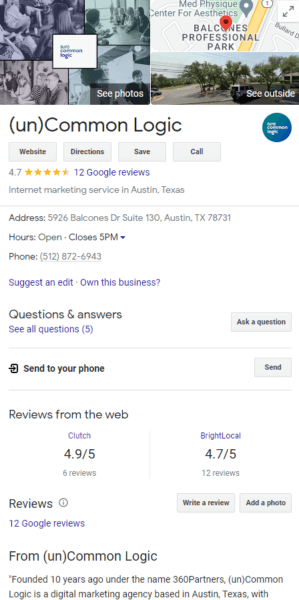
See how easy it is to select a category during GBP setup?
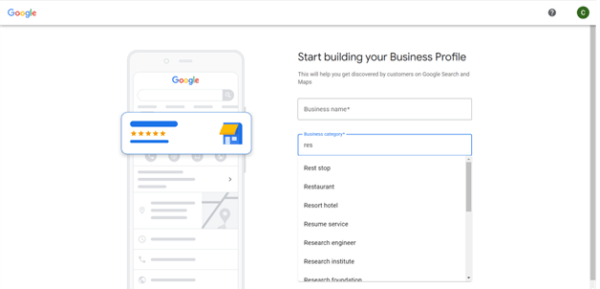
Once your GBP profile is properly set up, make sure you optimize it through regular GBP posts. Does it make a difference? Absolutely – one of our clients, a local auto tire and services provider, saw a 58% increase in website visits and a 7% increase in calls after implementing a local SEO strategy which focused on their GBP profile.
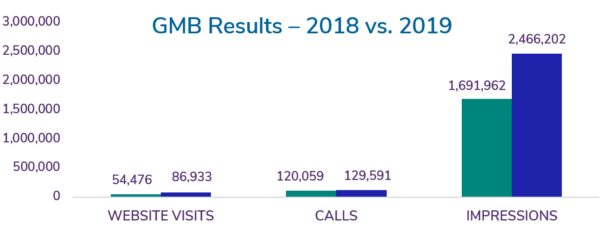
#2: Use Geo-Targeting
Organic social media is a valuable tool in connecting with your customers but the next step involves utilizing paid ads to help ensure you’ll reach even more of the right customers. Investing in paid online advertising with geo-targeted ads helps you reach a specific geo-location ensuring you are targeting a highly relevant audience. For example, if your business is based out of Austin (like us) you would target only those people living in Austin. Boosting Facebook posts, promoting your tweets on Twitter, and utilizing LinkedIn ads are all ways you can target a specific audience with demographic information. Selecting the interests and other demographic information of your potential customers will help narrow down your targeting.
#3: Utilize Text Message Marketing
Sending marketing text messages to your customers or prospects is another way to market to your local demographic. Reaching your client with a text is a valuable and effective way to target an engaged audience. You can entice customers to sign up with discount codes, exclusive information, or first access to drops/events. They can access your list through a form on your website, or by texting a keyword to join (like text “marketing” to join). Encouraging your customers to sign up for regular text promotions keeps you top of mind and pushes your audience further through the buyer’s journey.
How do you effectively optimize your mobile marketing strategies?
According to Statista, almost 60% of website traffic comes from smartphones. Given that, now more than ever it is essential to optimize your website for mobile. Ensuring your website is tailored to mobile devices will help capture important audiences no matter where they are. Below are what we recommend as the first mobile marketing tactics you should implement.
#1: Optimize Website Speed
When people are on their smartphones, success of a website often comes down to speed. If someone is researching something on their phone, they typically want the information quickly. Data shows faster mobile websites have lower bounce rates, higher conversion rates, and rank higher in organic search.
When analyzing your page speed, there are a few reasons your website may be loading slowly. Eliminating unused scripts and plugins and reducing your images’ sizes can help improve your website speed. You can check your page speed by using Google PageSpeed Insights, a free tool by Google that can help you check both your desktop and mobile page speeds. By increasing your website speed, you will improve user experience and increase mobile conversions.
#2: Implement a Responsive Layout
Building a responsive website is the best way to create a site that works well on both desktop and mobile. You may be wondering, what is a responsive website? A responsive site is one that can adjust to any device so a user can easily read your web content, click on any buttons, and navigate your site easily. Ensuring your website is responsive is a great way to make your website mobile friendly without limiting information.
Updating your website to work on many different devices may seem overwhelming but building a responsive website on your own isn’t difficult. Responsive design has now become the norm, and there are many tools that make it easier. Additionally, website builders also offer responsive templates, so you can select your template, and you’re good to go. Not sure if your website is responsive? Responsinator is a resource you can use to test and Boot Strap is a free resource you can use to help make your website more responsive.
#3: Make Information Easy to Find
Mobile screens are naturally much smaller than a desktop screen; therefore, the limited space makes having concise, easy to find information even more imperative. Utilizing banners, buttons, and putting important information higher up on the page are some easy ways to ensure mobile users are finding relevant information.
How do you know your information is easy for users to find and read on their mobile devices? Through copy and design testing. For one B2B client, 40% of their total traffic was on mobile devices but they had 80% lower engagement on mobile vs desktop. After applying best practices and implementing copy and design testing, engagement on mobile increased 157% and registration starts increased 104%. Here’s the mobile homepage before:
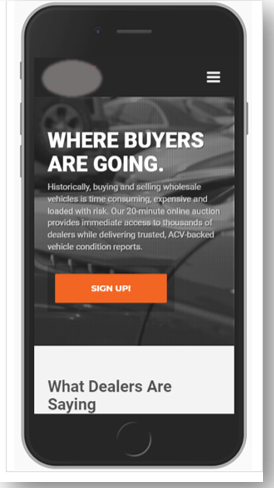
And here’s what it looked like after:
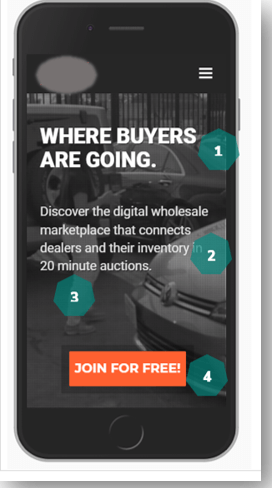
Our best practice and tested changes included:
- Increasing the main graphic to cover the full screen
- Reducing the copy to focus on the platform’s main values
- Increasing the opacity to improve the contrast ratio
- Increasing the visibility (size) and value proposition (cost) for the main CTA
Once your site is optimized for mobile, you’ll want to be sure your mobile paid media efforts are, too. We take the unique aspects of your target market when they’re on their mobile devices into account to ensure your mobile ads, landing pages, and tracking are designed, monitored, and managed separately from your desktop paid media for optimal results.
How do you utilize local and mobile marketing techniques together?
When looking at these strategies, you can see that optimizing for local and mobile often go hand in hand. Ensuring all business information is accurate and easy to find will help local users searching for you on their mobile phones. Implementing a responsive layout will help people visiting from text marketing or social media on their phones to access all information easily. Making information easy to find will not only help your local listings but will also create a more seamless experience for mobile users. And our digital marketing team has extensive experience strategizing and implementing integrated local and mobile strategies and tactics for optimized results.
Contact us to talk about how our mobile and local digital marketing expertise or overall digital marketing approach can help your business.
Want to learn more? See how a local SEO strategy can grow your business or learn more about optimizing your users’ mobile experience and other key SEO tactics.
When thinking about websites, businesses often default to thinking of users strictly accessing their site through a desktop browser, but now more than ever, people are using smartphones to find information on the go. Maybe they are hungry and looking for a place to eat. They search for "restaurants near me" and if you own a restaurant in that area, you’ll want your business' name to be near the top of that list.
In order to show up in situations like this, you need good SEO or paid search. Once the user reaches your site, it is essential that it is easy for the mobile user to navigate which requires conversion rate optimization services. Additionally, to understand your online user thoroughly, especially if their user journey includes accessing your site both on mobile and desktop devices at different times, it is important that your Google Analytics is correctly set up. Tailoring online profiles, websites, landing pages, paid media, and other steps in the user journey for local and mobile traffic is sometimes given short shrift, but not leaning into these audiences could be a missed opportunity for your business.
How do you effectively optimize your local marketing strategies?
Putting everything into place so that your website is prepared to capitalize on local business is an easy way to help your business grow. Effectively optimizing for local business will help you stay relevant and bring in more business. Establishing the radius of people to target, understanding your local demographic, and determining how they are finding you are all ways you can tailor your website to your local audience. Check out our recommended first-steps for local marketing tactics to ensure you're capturing as much local traffic as possible.
#1: Set Up & Optimize Your Google Business Profile
When people are out and about, they typically use their smartphones to find businesses, and capitalizing on this on-the-go traffic is important to the success of your business. One easy way to capture this market is by setting up your business on listing sites like Google Business Profile (GBP). Ensuring your name and business information is current, accurate, and complete will boost your incoming business from mobile users. When setting this up, make sure the information is consistent across all online properties (website, GBP, and other directories).
Another important item to pay attention to during set up is selecting the proper business category for your profile. Selecting the proper category will help your business appear when a user searches for specific category in Google Maps and search engine results pages.
Here's an example of a properly set up Google Business Profile:

See how easy it is to select a category during GBP setup?

Once your GBP profile is properly set up, make sure you optimize it through regular GBP posts. Does it make a difference? Absolutely – one of our clients, a local auto tire and services provider, saw a 58% increase in website visits and a 7% increase in calls after implementing a local SEO strategy which focused on their GBP profile.

#2: Use Geo-Targeting
Organic social media is a valuable tool in connecting with your customers but the next step involves utilizing paid ads to help ensure you’ll reach even more of the right customers. Investing in paid online advertising with geo-targeted ads helps you reach a specific geo-location ensuring you are targeting a highly relevant audience. For example, if your business is based out of Austin (like us) you would target only those people living in Austin. Boosting Facebook posts, promoting your tweets on Twitter, and utilizing LinkedIn ads are all ways you can target a specific audience with demographic information. Selecting the interests and other demographic information of your potential customers will help narrow down your targeting.
#3: Utilize Text Message Marketing
Sending marketing text messages to your customers or prospects is another way to market to your local demographic. Reaching your client with a text is a valuable and effective way to target an engaged audience. You can entice customers to sign up with discount codes, exclusive information, or first access to drops/events. They can access your list through a form on your website, or by texting a keyword to join (like text “marketing” to join). Encouraging your customers to sign up for regular text promotions keeps you top of mind and pushes your audience further through the buyer’s journey.
How do you effectively optimize your mobile marketing strategies?
According to Statista, almost 60% of website traffic comes from smartphones. Given that, now more than ever it is essential to optimize your website for mobile. Ensuring your website is tailored to mobile devices will help capture important audiences no matter where they are. Below are what we recommend as the first mobile marketing tactics you should implement.
#1: Optimize Website Speed
When people are on their smartphones, success of a website often comes down to speed. If someone is researching something on their phone, they typically want the information quickly. Data shows faster mobile websites have lower bounce rates, higher conversion rates, and rank higher in organic search.
When analyzing your page speed, there are a few reasons your website may be loading slowly. Eliminating unused scripts and plugins and reducing your images’ sizes can help improve your website speed. You can check your page speed by using Google PageSpeed Insights, a free tool by Google that can help you check both your desktop and mobile page speeds. By increasing your website speed, you will improve user experience and increase mobile conversions.
#2: Implement a Responsive Layout
Building a responsive website is the best way to create a site that works well on both desktop and mobile. You may be wondering, what is a responsive website? A responsive site is one that can adjust to any device so a user can easily read your web content, click on any buttons, and navigate your site easily. Ensuring your website is responsive is a great way to make your website mobile friendly without limiting information.
Updating your website to work on many different devices may seem overwhelming but building a responsive website on your own isn’t difficult. Responsive design has now become the norm, and there are many tools that make it easier. Additionally, website builders also offer responsive templates, so you can select your template, and you’re good to go. Not sure if your website is responsive? Responsinator is a resource you can use to test and Boot Strap is a free resource you can use to help make your website more responsive.
#3: Make Information Easy to Find
Mobile screens are naturally much smaller than a desktop screen; therefore, the limited space makes having concise, easy to find information even more imperative. Utilizing banners, buttons, and putting important information higher up on the page are some easy ways to ensure mobile users are finding relevant information.
How do you know your information is easy for users to find and read on their mobile devices? Through copy and design testing. For one B2B client, 40% of their total traffic was on mobile devices but they had 80% lower engagement on mobile vs desktop. After applying best practices and implementing copy and design testing, engagement on mobile increased 157% and registration starts increased 104%. Here's the mobile homepage before:

And here's what it looked like after:

Our best practice and tested changes included:
- Increasing the main graphic to cover the full screen
- Reducing the copy to focus on the platform’s main values
- Increasing the opacity to improve the contrast ratio
- Increasing the visibility (size) and value proposition (cost) for the main CTA
Once your site is optimized for mobile, you’ll want to be sure your mobile paid media efforts are, too. We take the unique aspects of your target market when they’re on their mobile devices into account to ensure your mobile ads, landing pages, and tracking are designed, monitored, and managed separately from your desktop paid media for optimal results.
How do you utilize local and mobile marketing techniques together?
When looking at these strategies, you can see that optimizing for local and mobile often go hand in hand. Ensuring all business information is accurate and easy to find will help local users searching for you on their mobile phones. Implementing a responsive layout will help people visiting from text marketing or social media on their phones to access all information easily. Making information easy to find will not only help your local listings but will also create a more seamless experience for mobile users. And our digital marketing team has extensive experience strategizing and implementing integrated local and mobile strategies and tactics for optimized results.
Contact us to talk about how our mobile and local digital marketing expertise or overall digital marketing approach can help your business.
Want to learn more? See how a local SEO strategy can grow your business or learn more about optimizing your users’ mobile experience and other key SEO tactics.

